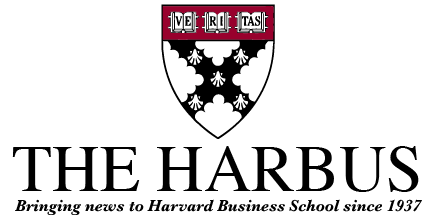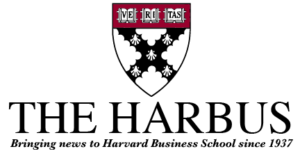A concerted and ongoing commitment to the environment can serve as a point of strategic differentiation. This was the message expressed by Michael Crooke, CEO of the Lost Arrow Corporation, parent company of Patagonia, Inc. while addressing an audience of about 150 students, visitors and local Bostonians on Feb 18th, at the invitation of the HBS Sustainable Development Society.
Crooke exuded positive energy when addressing the crowd, commenting on the beauty of the HBS campus even on a cold February afternoon. He enthusiastically described the interlocking elements of the business, including the financial, social and environmental pieces that combine to foster a virtuous cycle: the company’s environmental and social commitment attracts loyal customers and employees, thereby improving the financial performance of the firm, ultimately leading to greater customer loyalty and deeper employee commitment. This philosophy is a self-sustaining one, illustrated by a lotus blossom surrounded by different icons.
Unlike some other companies that give back to the environment as a casual afterthought and highlight it in their annual report, Patagonia’s commitment is genuine and it can be traced back to the company’s founder Yvon Choinard in 1970. Chouinard, in addition to being a world-class climber, is a modern Renaissance man, devoting his early efforts to the clean climbing movement and distinguishing his fledgling venture which sold climbing tools and hardware from other manufacturers.
Chouinard’s goal to establish Patagonia as a business meant “to inspire and implement solutions to the environmental crisis” remains intact today, and is most evident in the company’s sourcing methods. In 1993, Patagonia was the first outdoor retailer to begin using Post-Consumer Recycled (PCR(r)) fleece, manufactured from recycled soda bottles. By relying on this material, the company has diverted 40 million soda bottles from landfills and saved 42 million gallons of oil.
But what was immediately clear was that Crooke certainly possessed the skill-set to run Patagonia – as shown by his resume at the time founder Yvon Chouinard turned over the reigns in 1999. After earning his MBA, Crooke moved from one outdoor sports retailer to the next, leaving each brand more energized and better-positioned through his efforts. From Yakima, the high-end, roof rack company that serves a customer base, “whose gear-kayaks, skis and bikes, costs more than their cars,” to Moonstone, a brand that consistently meets the rigorous performance needs of hard-core mountaineers, Crooke paid his dues in the industry to get to his current position.
Crooke alluded to the drawbacks business school graduates might face through employment at a firm like Patagonia, namely a compensation package that cannot hope to match those we might expect upon graduation. If money is but one part of the elusive ideal job-search equation, what benefits can Patagonia offer in its place? The company boasts flexible work schedules and on-site day care, perks that have earned Patagonia a consistent place among Working Mother’s list of family-friendly companies.
The Patagonia campus is located in Ventura, CA and just a few pictures of the headquarters proved that its corporate philosophy is evident even in its physical plant. The campus looked beautiful, with buildings that seemed in harmony with the California locale – and just like its garments that are fabricated from materials that won’t damage the earth, the 13 buildings are composed of self-sustaining materials like straw-bale. These structures are entirely wind-powered and each is committed to the goal of reducing greenhouse gas emissions by five percent per year, a higher standard than the Kyoto Protocols flatly rejected by the Bush Administration.
Crooke also described Patagonia’s Environmental Internships, 8-week periods of voluntary service that all employees are encouraged to undertake at a nature-related charity or environmental cause of their choice. From a business standpoint, these fully-paid “sabbaticals” make perfect sense. When an employee spends two months with the Access Fund or at Yosemite National Park, Patagonia derives additional credibility for not merely displaying pretty pictures of nature in its glossy catalogues, but actually making a difference through environmental stewardship.
Equally crucial, it re-connects employees back to the demanding marketplace it serve – outdoor athletes who push Patagonia’s gear to the limits of performance.
But this leads me to ask whether or not Patagonia’s target market is genuine. The company calls its collection of sponsored and unaffiliated athletes “dirtbags”, people I’ve long admired for their ability to ditch a day of work for the promise of skiing untouched powder. This is the company’s ostensible target segment. Yet if you were to segment the Patagonia customer base which patronizes the posh Newbury Street store, you would likely find very few genuine dirtbags who actually have the disposable income necessary to afford the brand’s ultra-high prices.
This disparity is not surprising if we look at the economics: the overall size of the hardcore athlete market, their infrequency of repeat purchases (this is a customer segment that uses its gear until the fibers fall apart), and the tendency of these users to flee to the next coolest piece of gear-particularly if it’s initially given away for free.
However, these same dirtbags have the ability to shape the decisions of those around them through word-of-mouth and more importantly, by their own achievements in the outdoor arena by pushing the envelope of physical endurance and risk. While I first struggled with the sincerity of Patagonia’s positioning, in the end, as an MBA poised to enter the global, competitive marketplace, I’m much more forgiving of preying upon yuppie wanderlust and tales of “weekend warrior” adventure from customers like me if it means continued great work to protect the open spaces in which we all live and play.

